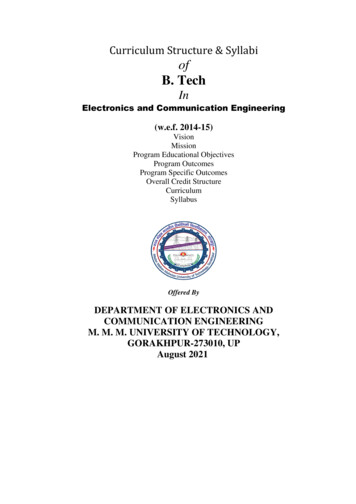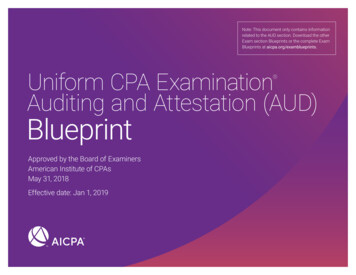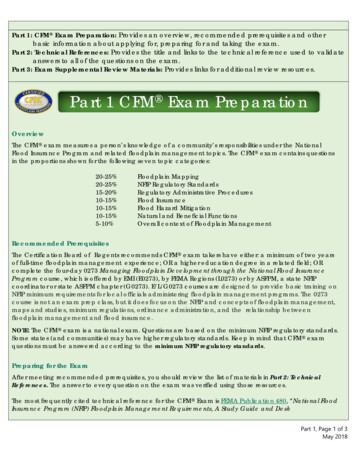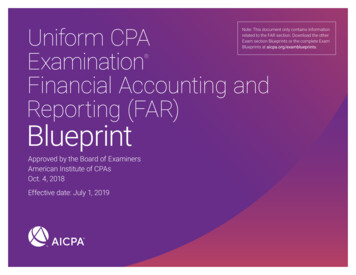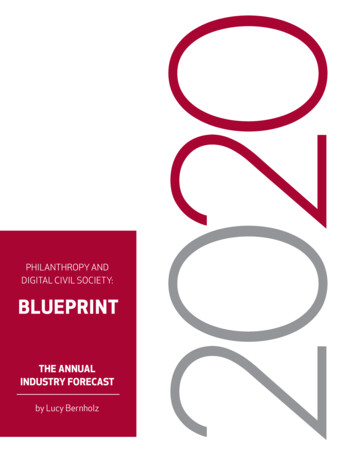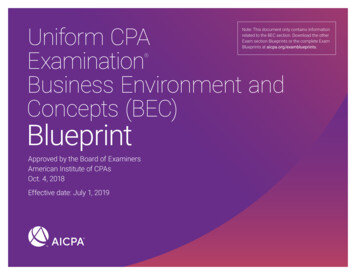
Transcription
Uniform CPAExaminationBusiness Environment andConcepts (BEC)Note: This document only contains informationrelated to the BEC section. Download the otherExam section Blueprints or the complete ExamBlueprints at aicpa.org/examblueprints. BlueprintApproved by the Board of ExaminersAmerican Institute of CPAsOct. 4, 2018Effective date: July 1, 2019Uniform CPA Examination Blueprintsi
Uniform CPA Examination BlueprintsTable of contents2AUD1Introduction: Uniform CPA Examination BlueprintsFAR1Auditing and Attestation (AUD)AUD2Section introductionAUD6Summary blueprintFinancial Accounting and Reporting (FAR)FAR2Section introductionFAR6Summary blueprintFAR7Area I — Conceptual Framework, Standard-Settingand Financial ReportingAUD7Area I — Ethics, Professional Responsibilitiesand General PrinciplesFAR13Area II — Select Financial Statement AccountsFAR19Area III — Select TransactionsAUD12Area II — Assessing Risk and Developinga Planned ResponseFAR24Area IV — State and Local GovernmentsAUD18Area III — Performing Further Proceduresand Obtaining EvidenceAUD23BEC1Area IV — Forming Conclusions and ReportingBusiness Environment and Concepts (BEC)REG1Regulation (REG)REG2Section introductionREG5Summary blueprintREG6Area I — Ethics, Professional Responsibilitiesand Federal Tax ProceduresBEC2Section introductionREG8Area II — Business LawBEC6Summary blueprintREG12Area III — Federal Taxation of Property TransactionsBEC7Area I — Corporate GovernanceREG15Area IV — Federal Taxation of IndividualsBEC9Area II — Economic Concepts and AnalysisREG18Area V — Federal Taxation of EntitiesBEC11Area III — Financial ManagementBEC13Area IV — Information TechnologyBEC16Area V — Operations ManagementUniform CPA Examination Blueprints1
IntroductionUniform CPA Examination BlueprintsThe Uniform CPA Examination (the Exam) is comprised of four sections, eachfour hours long: Auditing and Attestation (AUD), Business Environment andConcepts (BEC), Financial Accounting and Reporting (FAR) and Regulation (REG).The AICPA has adopted a skill framework for the Exam based on the revisedBloom’s Taxonomy of Educational Objectives. Bloom’s Taxonomy classifies acontinuum of skills that students can be expected to learn and demonstrate.The table below presents the design of the Exam by section, section time andquestion type.Approximately 600 representative tasks that are critical to a newly licensedCPA’s role in protecting the public interest have been identified. Therepresentative tasks combine both the applicable content knowledge and skillsrequired in the context of the work of a newly licensed CPA. Based on the natureof a task, one of four skill levels, derived from the revised Bloom’s Taxonomy,was assigned to each of the tasks, as dquestions (MCQs) simulations (TBSs)WrittencommunicationAUD4 hours728—BEC4 hours6243FAR4 hours668—REG4 hours768—The table below presents the scoring weight of multiple-choice questions(MCQs), task-based simulations (TBSs) and written communication for eachExam section.Skill levelsEvaluationThe examination or assessment of problems, anduse of judgment to draw conclusions.AnalysisThe examination and study of the interrelationshipsof separate areas in order to identify causes and findevidence to support inferences.ApplicationThe use or demonstration of knowledge, conceptsor techniques.Remembering andUnderstandingThe perception and comprehension of thesignificance of an area utilizing knowledge gained.Score weightingSectionMultiple-choicequestions (MCQs)Task-basedsimulations FAR50%50%—REG50%50%—Uniform CPA Examination Blueprints2
IntroductionUniform CPA Examination Blueprints (continued)The skill levels to be assessed on each section of the Exam are included in thetable below.SectionRemembering %35–45%25–35%—*Includes written communicationThe purpose of the blueprint is to: Document the minimum level of knowledge and skills necessary for initiallicensure. Assist candidates in preparing for the Exam by outlining the knowledge andskills that may be tested. Apprise educators about the knowledge and skills candidates will need tofunction as newly licensed CPAs. Guide the development of Exam questions.The tasks in the blueprints are representative and are not intended to be (norshould they be viewed as) an all-inclusive list of tasks that may be tested onthe Exam. It also should be noted that the number of tasks associated with aparticular content group or topic is not indicative of the extent such contentgroup, topic or related skill level will be assessed on the Exam.Each section of the Exam has a section introduction and a correspondingsection blueprint. The section introduction outlines the scope of the section, the contentorganization and tasks, the content allocation, the overview of content areas,the skill allocation and a listing of the section’s applicable reference literature. The section blueprint outlines the content to be tested, the associated skilllevel to be tested and the representative tasks a newly licensed CPA wouldneed to perform to be considered competent. The blueprints are organized bycontent AREA, content GROUP, and content TOPIC. Each topic includes oneor more representative TASKS that a newly licensed CPA may be expected tocomplete.Revised taxonomy see Anderson, L.W. (Ed.), Krathwohl, D.R. (Ed.), Airasian, P.W., Cruikshank, K.A., Mayer, R.E., Pintrich, P.R., Raths, J., & Wittrock, M.C. (2001). A taxonomy for learning, teaching, and assessing: A revision of Bloom’s Taxonomy ofEducational Objectives (Complete Edition). New York: Longman. For original taxonomy see Bloom, B.S. (Ed.), Engelhart, M.D., Furst, E.J., Hill, W.H., & Krathwohl, D.R. (1956). Taxonomy of educational objectives: The classification of educationalgoals. Handbook 1: Cognitive domain. New York: David McKay.Uniform CPA Examination Blueprints3
Uniform CPA ExaminationBusiness Environment andConcepts (BEC)BlueprintUniform CPA Examination Blueprints: Business Environment and Concepts (BEC)BEC1
Section introductionBusiness Environment and ConceptsThe Business Environment and Concepts (BEC) section of the Uniform CPAExamination (the Exam) tests knowledge and skills that a newly licensed CPAmust demonstrate when performing:Content allocationThe following table summarizes the content areas and the allocation of contenttested in the BEC section of the Exam: Audit, attest, accounting and review services Financial reporting Tax preparationContent areaAllocationArea ICorporate Governance17–27%Area IIEconomic Concepts and Analysis17–27%Area IIIFinancial Management11–21%Area IVInformation Technology15-25%Area VOperations Management15-25% Other professional responsibilities in their role as certified public accountantsThe content areas tested under the BEC section of the Exam encompass fivediverse subject areas. These content areas are corporate governance, economicconcepts and analysis, financial management, information technology andoperations management. Reference materials relevant to the BEC section of theExam are included under References at the conclusion of this introduction.Content organization and tasksThe BEC section blueprint is organized by content AREA, content GROUP andcontent TOPIC. Each group or topic includes one or more representative TASKSthat a newly licensed CPA may be expected to complete when performing audit,attest, accounting and review services, financial reporting, tax preparation orother professional responsibilities.The tasks in the blueprint are representative. They are not intended to be (norshould they be viewed as) an all-inclusive list of tasks that may be tested in theBEC section of the Exam. Additionally, it should be noted that the number oftasks associated with a particular content group or topic is not indicative ofthe extent such content group, topic or related skill level will be assessedon the Exam. Similarly, examples provided within the task statements shouldnot be viewed as all-inclusive.Uniform CPA Examination Blueprints: Business Environment and Concepts (BEC)Overview of content areasArea I of the BEC section blueprint covers several topics related to CorporateGovernance, including the following: Knowledge and use of internal control frameworks Knowledge and use of enterprise risk management frameworks Identifying key corporate governance provisions of regulatory frameworks andlaws such as the Sarbanes-Oxley Act of 2002BEC2
Section introductionBusiness Environment and Concepts(continued)Area II of the BEC section blueprint covers several topics related to EconomicConcepts and Analysis, including the following:Area IV of the BEC section blueprint covers several topics related toInformation Technology (IT), including the following: Knowledge of economic concepts and analysis that would demonstrate anunderstanding of the impact of business cycles on an entity’s industry orbusiness operation Understanding the role of IT and systems, including the use of data insupporting business decisions. Determining market influences on the business environment, such asglobalization Determining the business reasons for, and the underlying economic substanceof, transactions and their accounting implications Understanding financial risks and the methods for mitigating the impact ofthese risksArea III of the BEC section blueprint covers several topics related to FinancialManagement, including the following: Assessing the factors influencing a company’s capital structure, suchas risk, leverage, cost of capital, growth rate, profitability, asset structure andloan covenants Identifying IT-related risks associated with an entity’s information systemsand processes, such as processing integrity, protection of information andsystem availability, including those risks introduced by the relationships withthird-parties. Identifying application and IT general control activities, whether manual,IT dependent or automated, that are responsive to IT-related risks, suchas access and authorization controls, system implementation testing andincident response plans.Area V of the BEC section blueprint covers several topics related to OperationsManagement, including the following: Understanding business operations and use of quality control initiatives andperformance measures to improve operations Calculating metrics associated with the components of working capital, suchas current ratio, quick ratio, cash conversion cycle, turnover ratios Application of cost accounting concepts and use of variance analysistechniques Determining the impact of business decisions on working capital Utilizing budgeting and forecasting techniques to monitor progress andenhance accountability Understanding commonly used financial valuation and decision models andapplying that knowledge to assess assumptions, calculate the valueof assets and compare investment alternativesUniform CPA Examination Blueprints: Business Environment and Concepts (BEC)BEC3
Section introductionBusiness Environment and Concepts(continued)Skill allocationThe Exam focuses on testing higher order skills. Based on the nature of the task,each representative task in the BEC section blueprint is assigned a skill level.BEC section considerations related to the skill levels are discussed below.Skill levelsEvaluationThe examination or assessment of problems, anduse of judgment to draw conclusions.AnalysisThe examination and study of the interrelationshipsof separate areas in order to identify causes and findevidence to support inferences.ApplicationThe use or demonstration of knowledge, conceptsor techniques.Remembering andUnderstandingThe perception and comprehension of thesignificance of an area utilizing knowledge gained. Application is also tested in all five areas of the BEC section. Applicationtasks focus on general topics such as those found in the subjects ofeconomics and information technology, and the day-to-day financialmanagement tasks that newly licensed CPAs perform, such as thoseinvolving calculations involving ratios, valuation and budgeting. Analysis skills, tested in Areas II, III and V involve tasks that require ahigher level of analysis and interpretation. These tasks, such as comparinginvestment alternatives using calculations of financial metrics, financialmodeling, forecasting and projection, frequently require newly licensed CPAsto gather evidence to support inferences.The representative tasks combine both the applicable content knowledgeand the skills required in the context of the work that a newly licensed CPAwould reasonably be expected to perform. The BEC section does not test anycontent at the Evaluation skill level as newly licensed CPAs are not expected todemonstrate that level of skill in regards to the BEC content. Remembering and Understanding is tested in all five areas of the BEC section.Remembering and understanding tasks focus on the knowledge necessaryto demonstrate an understanding of the general business environment andbusiness concepts, such as those involving enterprise risk management.Uniform CPA Examination Blueprints: Business Environment and Concepts (BEC)BEC4
Section introductionBusiness Environment and Concepts(continued)References — Business Environment and Concepts The Committee of Sponsoring Organizations of the Treadway Commission (COSO):– Internal Control – Integrated Framework– Enterprise Risk Management – Integrating with Strategy and Performance– COSO-issued application material, thought papers and guides related to the above frameworks Sarbanes-Oxley Act of 2002:– Title III, Corporate Responsibility– Title IV, Enhanced Financial Disclosures– Title VIII, Corporate and Criminal Fraud Accountability– Title IX, White-Collar Crime Penalty Enhancements– Title XI, Corporate Fraud Accountability Current business periodicals Current textbooks on:– Accounting Information Systems– Budgeting and Measurement– Corporate Governance– Economics– Enterprise Risk Management– Finance– Management– Management Information Systems– Managerial Accounting– Production OperationsUniform CPA Examination Blueprints: Business Environment and Concepts (BEC)BEC5
Business Environment and Concepts (BEC)Summary blueprintContent area allocationWeightI. Corporate Governance17–27%II. Economic Concepts and Analysis17–27%III. Financial Management11–21%IV. Information Technology15–25%V. Operations Management15–25%Skill cation50–60%Remembering and Understanding15–25%Uniform CPA Examination Blueprints: Business Environment and Concepts (BEC)BEC6
Business Environment and Concepts (BEC)Area I — Corporate Governance(17–27%)SkillContent group/topicRemembering sentative taskA. Internal control frameworks1. Purpose andobjectives2. Componentsand principlesDefine internal control within the context of the COSO internal control framework,including the purpose, objectives and limitations of the framework.Identify and define the components, principles and underlying structure of the COSO internalcontrol framework.Apply the COSO internal control framework to identify entity and transaction level risks(inherent and residual) related to an organization’s compliance, operations and reporting(internal and external, financial and non-financial) objectives.Apply the COSO internal control framework to identify risks related to fraudulent financialand non-financial reporting, misappropriation of assets and illegal acts, including the riskof management override of controls.Apply the COSO internal control framework to identify controls to meet an entity’scompliance, operations and reporting (internal and external, financial and non-financial)objectives, throughout an entity’s structure, from entity-wide through sub-units, down tothe transactional level.Apply the COSO internal control framework to identify an appropriate mix of automatedand manual application controls, (e.g., authorization and approval, verifications, physicalcontrols, controls over standing data, reconciliations and supervisory controls) to preventand detect errors in transactions.Describe the corporate governance structure within an organization (e.g., tone at the top,policies, steering committees, oversight and ethics).Uniform CPA Examination Blueprints: Business Environment and Concepts (BEC)BEC7
Business Environment and Concepts (BEC)Area I — Corporate Governance(17–27%) (continued)SkillContent group/topicRemembering sentative taskB. Enterprise risk management (ERM) frameworks1. Purpose andobjectives2. Componentsand principlesDefine ERM within the context of the COSO ERM framework, including the purpose andobjectives of the framework.Identify and define the components, principles and underlying structure of the COSO ERMframework.Understand the relationship among risk, business strategy and performance within thecontext of the COSO ERM framework.Apply the COSO ERM framework to identify risk/opportunity scenarios in an entity.C. Other regulatory frameworks and provisionsIdentify and define key corporate governance provisions of the Sarbanes-Oxley Actof 2002 and other regulatory pronouncements.Identify regulatory deficiencies within an entity by using the requirements associated withthe Sarbanes-Oxley Act of 2002.Uniform CPA Examination Blueprints: Business Environment and Concepts (BEC)BEC8
Business Environment and Concepts (BEC)Area II — Economic Concepts and Analysis (17–27%)SkillContent group/topicRemembering sentative taskA. Economic and business cycles - measures and indicatorsIdentify and define business cycles (trough, expansion, peak, recession) and conditions andgovernment policies that impact an entity’s industry or operations.Use appropriate inputs to calculate economic measures and indicators (e.g., Nominal and RealGDP, Consumer Price Index, Aggregate Demand Curve and Money Supply) and apply leading,coincident and lagging indicators (e.g., bond yields, new housing starts, personal income andunemployment).Use economic measures and indicators to explain the impact on an entity’s industry andoperations due to changes in government fiscal policy, monetary policy, regulations, tradecontrols and other actions.Use economic measures and indicators to explain the impact on an entity’s industry andoperations due to changes in business cycles and economic conditions, caused by factors suchas exchange rates, inflation, productivity, state of the global economy, unemployment levels, etc.B. Market influences on businessIdentify and define the key factors related to the economic marketplace (e.g., competition, currencies,globalization, supply and demand and trade) and how they generally apply to a business entity.Identify and define market influences (e.g., economic, environmental, governmental, political, legal,social and technological).Determine the impact of market influences on the overall economy (e.g., consumer demand, laborsupply, market prices, production costs and volatility).Determine the impact of market influences on an entity’s business strategy, operations and risk (e.g.,increasing investment and financial leverage, innovating to develop new product offerings, seekingnew foreign and domestic markets and undertaking productivity or cost-cutting initiatives).Determine the business reasons for, and explain the underlying economic substance of, significanttransactions (e.g., business combinations and divestitures, product line diversification, productionsourcing and public and private offerings of securities).Uniform CPA Examination Blueprints: Business Environment and Concepts (BEC)BEC9
Business Environment and Concepts (BEC)Area II — Economic Concepts and Analysis(17–27%) (continued)SkillContent group/topicRemembering sentative taskC. Financial risk management1. Market, interestrate, currency,liquidity, credit,price and otherrisks2. Means formitigating/controllingfinancial risksUniform CPA Examination Blueprints: Business Environment and Concepts (BEC)Calculate and use ratios and measures to quantify risks associated with interest rates,currency exchange, liquidity, prices, etc. in a business entity.Identify strategies to mitigate financial risks (e.g., market, interest rate, currency andliquidity) and quantify their impact on a business entity.BEC10
Business Environment and Concepts (BEC)Area III — Financial Management(11–21%)SkillContent group/topicRemembering sentative taskA. Capital structureDescribe an organization's capital structure and related concepts, such as cost of capital,asset structure, loan covenants, growth rate, profitability, leverage and risk.Calculate the cost of capital for a given financial scenario.Compare and contrast the strategies for financing new business initiatives and operationswithin the context of an optimal capital structure, using statistical analysis where appropriate.B. Working capital1. Fundamentalsand key metricsof workingcapitalmanagement2. Strategies formanagingworkingcapitalCalculate the metrics associated with the working capital components, such as current ratio,quick ratio, cash conversion cycle, inventory turnover and receivables turnover.Detect significant fluctuations or variances in the working capital cycle using working capitalratio analyses.Compare inventory management processes, including pricing and valuation methods, todetermine the effects on the working capital of a given entity.Compare accounts payable management techniques, including usage of discounts, factorsaffecting discount policy, uses of electronic funds transfer as a payment method anddetermination of an optimal vendor payment schedule in order to determine the effects on theworking capital of a given entity.Distinguish between corporate banking arrangements, including establishment of lines ofcredit, borrowing capacity and monitoring of compliance with debt covenants in order todetermine the effects on the working capital of a given entity.Interpret the differences between the business risks and the opportunities in an entity's creditmanagement policies to determine the effects on the working capital of a given entity.Analyze the effects on working capital caused by financing using long-term debt and/orshort-term debt.Uniform CPA Examination Blueprints: Business Environment and Concepts (BEC)BEC11
Business Environment and Concepts (BEC)Area III — Financial Management(11–21%) (continued)SkillContent group/topicRemembering sentative taskC. Financial valuation methods and decision modelsIdentify and define the different financial valuation methods and their assumptions,including but not limited to fair value, Black-Scholes, Capital Asset Pricing Model andDividend Discount Model.Identify and define the different financial decision models and assumptions involvedin making decisions relating to asset and investment management, debt, equityand leasing.Identify the sources of data and factors that management considers in forming theassumptions used to prepare an accounting estimate.Describe the process and framework within which management exercises itsresponsibilities over the review and approval of accounting estimates.Calculate the value of an asset using commonly accepted financial valuation methods.Compare investment alternatives using calculations of financial metrics (e.g., paybackperiod, net-present value, economic value added, cash flow analysis and internal rate ofreturn), financial modeling, forecasting, projection and analysis techniques.Compare options in a lease vs. buy decision scenario.Uniform CPA Examination Blueprints: Business Environment and Concepts (BEC)BEC12
Business Environment and Concepts (BEC)Area IV — Information Technology(15–25%)SkillContent group/topicRemembering sentative taskA. Understanding of information technology (IT)1. Organization andgovernanceExplain the role that IT people, processes and strategies play in determining andsupporting an entity’s overall vision and strategy.Describe the IT governance structure within an entity (e.g., tone at the top, policies, frameworks,steering committees and oversight).2. Systems andprocessesDefine the basics of hardware, software, databases, networks, mobile technology, etc.used by an entity internally, externally and through outsourcing arrangements (e.g.,application service providers and cloud computing).Understand the flow of transactions represented in a flowchart, data diagram and systeminterface diagram.Identify the role of information systems (e.g., enterprise and application systems) in keybusiness processes (e.g., sales, cash collections, purchasing, disbursements, humanresources, payroll, production, treasury, fixed assets, general ledger and reporting).3. DataUnderstand key characteristics of a relational database (e.g., data dictionary, data types,tables, records, fields, relationships, keys, views, queries and reports).Recognize the role of big data in supporting business decisions.Use business intelligence (including data analytics and statistics) to support businessdecisions.B. Risk associated with IT1. Risk assessment2. System developmentand maintenanceUniform CPA Examination Blueprints: Business Environment and Concepts (BEC)Identify IT-related risks and describe mitigation strategies given risk severity, probabilityand costs.Determine the fundamental issues and risks associated with selecting, developing andimplementing new information systems or maintaining existing information systems.BEC13
Business Environment and Concepts (BEC)Area IV — Information Technology(15–25%) (continued)SkillContent group/topicRemembering sentative taskB. Risk associated with IT (continued)3. Processing integrity4. Security, availability,confidentiality andprivacyDetermine the risks associated with ensuring the completeness, accuracy and continuedprocessing integrity in input, storage, processing and output processes.Identify system access and segregation of duties risks.Identify the risks (e.g., cybersecurity and internal) associated with protecting sensitive andcritical information (e.g., proprietary and personal information) within information systems(including processing, storing and transmitting information internally and with externalparties).Perform threat identification to identify risks related to information confidentiality.Perform threat identification to identify risks related to system availability.C. Controls that respond to risks associated with IT1. Applicationcontrols2. General ITcontrolsDetermine the role and appropriateness of input, storage, processing and outputapplication controls (e.g., authorizations, approvals, tolerance levels, input edits andconfigurations) to support completeness, accuracy and continued processing integrity.Understand the controls and testing strategies used in selecting, developing andimplementing new information systems.Identify effective IT control activities, including manual, IT dependent and automatedcontrols, as well as preventive, detective and corrective controls.Uniform CPA Examination Blueprints: Business Environment and Concepts (BEC)BEC14
Business Environment and Concepts (BEC)Area IV — Information Technology(15–25%) (continued)SkillContent group/topicRemembering sentative taskC. Controls that respond to risks associated with IT (continued)3. Logical andphysical controlsIdentify logical and physical access controls (e.g., roles and rights and segregation ofduties).Identify the controls associated with protecting sensitive and critical information (e.g.,proprietary and personal) within information systems.Determine responses to information system confidentiality risks (e.g., incident responseplan).4. Continuity andrecovery plansUniform CPA Examination Blueprints: Business Environment and Concepts (BEC)Determine responses to system availability risks (e.g., data backup and recoveryprocedures and alternate processing facilities).BEC15
Business Environment and Concepts (BEC)Area V — Operations Management(15–25%)SkillContent group/topicRemembering sentative taskA. Financial and non-financial measures of performance managementCalculate financial and non-financial measures appropriate to analyze specific aspectsof an entity’s performance (e.g., Economic Value Added, Costs of Quality-Prevention vs.Appraisal vs. Failure).Determine which financial and non-financial measures are appropriate to analyzespecific aspects of an entity’s performance and risk profile (e.g., Return on Equity, Returnon Assets and Contribution Margin).B. Cost accounting1. Cost measurementconcepts, methodsand techniquesApply cost accounting concepts, terminology, methods and measurement techniqueswithin an entity.Differentiate the characteristics of fixed, variable and mixed costs within an entity.Compare and contrast the different costing methods such as absorption vs. variable andprocess vs. job order costing.2. Variance analysisUniform CPA Examination Blueprints: Business Environment and Concepts (BEC)Determine the appropriate variance analysis method to measure the key cost driversby analyzing business scenarios.BEC16
Business Envi
Uniform CPA Examination Blueprints i Approved by the Board of Examiners American Institute of CPAs Oct. 4, 2018 Effective date: July 1, 2019 Uniform CPA Examination Business Environment and Concepts (BEC) Blueprint Note: This document only contains information related to the BEC section. Download the other Exam section Blueprints or the .
